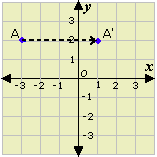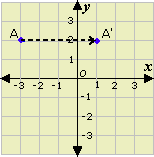Solved Examples and Worksheet for Transformations
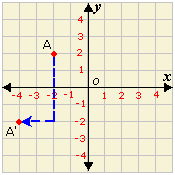
A. (4, - 2)
B. (- 4, 2)
C. (- 4, - 4)
D. (- 4, - 2)
Step: 1
Count down 4 units and left 2 units from the point A.
Step: 2
Graph A′.
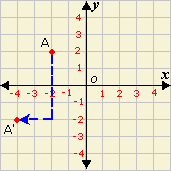

Step: 3
The coordinates of the image A′are (- 4, - 2).
Correct Answer is : (- 4, - 2)
A. (
B. (
C. (
D. None of the above
Step: 1
The x y x y
[The point P (x y
Step: 2
So, the rule for the translation is (x y x y
Correct Answer is : (x y x y
A. (
B. (
C. (
D. None of the above
Step: 1
The x
Step: 2
So, the point P has been translated to the left.
Step: 3
Number of units, it has been translated left = 5 - (- 2) = 7 units
Step: 4
Step: 5
So, the point P has been translated up.
Step: 6
Number of units, it has been translated up = 9 - 5 = 4 units
Step: 7
So, the rule for the translation is (x y → x y
Correct Answer is : (x y → x y
A.
B.
C.
D.
Step: 1
[Original line equation.]
Step: 2
The line has been translated 3 units left and 3 units up.
Step: 3
Step: 4
(y x
[Replace x x y y
Step: 5
[Distribute.]
Step: 6
Step: 7
[Simplify.]
Step: 8
So, equation of the image of the line is y x
Correct Answer is : y x
A. (
B. (
C. (
D. (
Step: 1
The x
Step: 2
So, the point P has been translated to the right.
Step: 3
Number of units, it has been translated right = 7 - 5 = 2 units.
Step: 4
The y
Step: 5
So, the point P has been translated down.
Step: 6
Number of units, it has been translated down = 3 - (- 2) = 5 units.
Step: 7
So, the rule is (x y → x y
Correct Answer is : (x y → x y
A. (- 1, 2)
B. (4, - 1)
C. (2, 1)
D. (1, - 2)
Step: 1
When (- 1, 2) is translated 3 units down, the y x
Step: 2
After translating (- 1,- 1) to 5 units right, the x
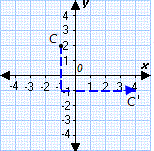

Step: 3
So, the coordinates of the new point C′ are (4, - 1).
Correct Answer is : (4, - 1)
A. Move 4 units left.
B. Move 2 units right.
C. Move 4 units right.
D. none of these
Step: 1
The coordinates before translation and after translation are (- 2, 3) and (2, 3).
Step: 2
The x y
Step: 3
Translation = 2 - (- 2) = 2 + 2 = 4 units right.
Step: 4
So, move 4 units right from (- 2, 3) to reach (2, 3).
Correct Answer is : Move 4 units right.
A. (- 6, 4)
B. (6, 4)
C. (10, - 4)
D. None of the above
Step: 1
When a point is reflected over a vertical line the y
Step: 2
The point P(- 2, - 4) is reflected over the line x
Step: 3
The distance of the point from the line x
Step: 4
So, the image of the point will be 6 units away from the line x
Step: 5
The x
Step: 6
So, the coordinates of the image of the point P(- 2, - 4) along x
Correct Answer is : (10, - 4)
A. (2, 7)
B. (- 2, - 7)
C. (2, 12)
D. (- 2, 12)
Step: 1
When a point is reflected over a horizontal line, the x
[The line y x
Step: 2
The point W (- 2, - 2) is reflected over the line y
Step: 3
The distance of the point (- 2, - 2), from the line y
Step: 4
So, the image of the point will be 7 units away from the line y
Step: 5
The y
Step: 6
So, the coordinates of the image are (- 2, 12).
Correct Answer is : (- 2, 12)
A. (-2, 4)
B. (2, 4)
C. (4, 2)
D. (-2, -4)
Step: 1
When point is rotated by 180o, only the signs of the x y
Step: 2
Represent the horizontal and the vertical distances of the point P(2, 4) as a rectangle.
Step: 3
Now tilt the rectangle by 180o as the point has to be rotated by 180o.
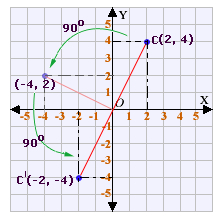

Step: 4
The coordinates of point C after rotating 180o are C'(-2, -4).
[Observe that the signs of the x y
Correct Answer is : (-2, -4)
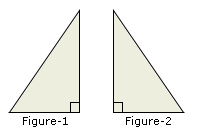
A. Reflection
B. Translation
C. Rotation
D. Dilation
Step: 1
Figure-2 represents the mirror image of Figure-1.
Step: 2
The transformation used in the Figure-1 to change as Figure-2 is 'reflection'.
Step: 3
So, the correct choice is reflection.
Correct Answer is : Reflection
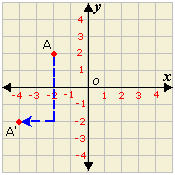
A. (- 4, - 4)
B. (- 4, - 2)
C. (4, - 2)
D. (- 4, 2)
Step: 1
Count down 4 units and left 2 units from the point A.
Step: 2
Graph A′.
Step: 3
The coordinates of the image A′ are (- 4, - 2).
Correct Answer is : (- 4, - 2)
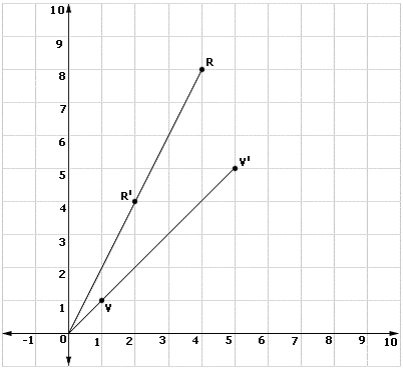
A. R dilated by scale factor
B. R dilated by scale factor 5, V dilated by scale factor
C. R increased by 5 times, V reduced by 5 times
D. None of the above
Step: 1
R (4, 8) is mapped to R′ (2, 4). Scale factor is 1 2
Step: 2
V (1, 1) is mapped to V′(5, 5). Scale factor is 5 and center (0, 0).
Correct Answer is : R dilated by scale factor 1 2
A. P (- 3, 4)
B. P (3, 4)
C. P (- 3, - 4)
D. P (3, - 4)
Step: 1
Represent the point P (3, 4) on the coordinate plane.
Step: 2
The point P (3, 4) is rotated counter clockwise by 180° as shown in the figure.
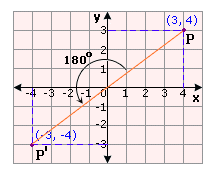

Step: 3
The coordinates of the point P after rotating 180° are P' (- 3, - 4).
Correct Answer is : P (- 3, - 4)
- Parallel Lines and Transversals-Gr 8-Solved Examples
- Angle Sum Theorem of a Triangle-Gr 8-Solved Examples
- Exterior Angle Theorem-Gr 8-Solved Examples
- Pythagorean Theorem-Gr 8-Solved Examples
- Distance Between Two Points-Gr 8-Solved Examples
- Volume of Cylinders-Gr 8-Solved Examples
- Volume of Cones-Gr 8-Solved Examples
- Volume of a Sphere-Gr 8-Solved Examples
Related Worksheet
- Rotation
